
Gardiner is a census-designated place (CDP) in Park County, Montana, United States, along the 45th parallel. As of the 2020 census, the population of the community and nearby areas was 833.

Fort Yellowstone was a U.S. Army fort, established in 1891 at Mammoth Hot Springs in Yellowstone National Park. Yellowstone was designated in 1872 but the Interior Department was unable to effectively manage the park. Administration was transferred to the War Department in August 1886 and General Philip Sheridan sent a company of cavalry to Mammoth Hot Springs to build a cavalry post. The army originally called the post Camp Sheridan in honor of General Sheridan but the name was changed to Fort Yellowstone in 1891 when construction of the permanent fort commenced. The army administered the park until 1918 when it was transferred to the newly created National Park Service. The facilities of Fort Yellowstone now comprise the Yellowstone National Park headquarters, the Horace Albright Visitor Center and staff accommodations.

Pump Geyser is a cone geyser located in the Upper Geyser Basin of Yellowstone National Park. It is in the Geyser Hill Complex which includes Aurum Geyser, Beehive Geyser, Big Cub Geyser. Doublet Pool, Giantess Geyser and Lion Geyser, among others.

Economic Geyser is a geyser in the Upper Geyser Basin of Yellowstone National Park in the United States.
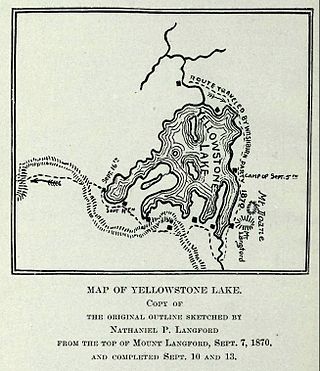
The Washburn Expedition of 1870 explored the region of northwestern Wyoming that two years later became Yellowstone National Park. Led by Henry D. Washburn and Nathaniel P. Langford, and with a U.S. Army escort headed by Lt. Gustavus C. Doane, the expedition followed the general course of the Cook–Folsom–Peterson Expedition made the previous year.

Dunraven Pass is a mountain pass on the Grand Loop Road between Tower and Canyon in Yellowstone National Park, Wyoming.

Tower Fall is a waterfall on Tower Creek in the northeastern region of Yellowstone National Park, in the U.S. state of Wyoming. Approximately 1,000 yards (910 m) upstream from the creek's confluence with the Yellowstone River, the fall plunges 132 feet (40 m). Its name comes from the rock pinnacles at the top of the fall. Tower Creek and Tower Fall are located approximately three miles south of Roosevelt Junction on the Tower-Canyon road.
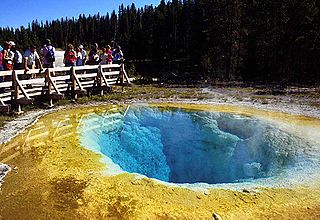
Morning Glory Pool is a hot spring in the Yellowstone Upper Geyser Basin of the United States. The spring is also known by the name Morning Glory Spring.

John F. Yancey also known as Uncle John Yancey was a Yellowstone National Park concessionaire who operated Yancey's Pleasant Valley hotel near Tower Junction in Yellowstone from 1882 until his death in 1903.

Trout Lake, formerly known as Fish Lake and Soda Butte Lake, is a 12 acres (0.049 km2) popular backcountry lake for hikers and anglers in Yellowstone National Park. The lake is located approximately .33 miles (0.53 km) north of the Northeast Entrance Road near the confluence of Pebble Creek and Soda Butte Creek. The lake sits in a depression on a high bench above the Soda Butte Creek Canyon. A steep trail through a Douglas fir forest leads to the lake. The trailhead is located at: 44°53′57″N110°7′21″W.

Lone Star Geyser is a cone type geyser located in the Lone Star Geyser Basin of Yellowstone National Park. The basin is a backcountry geyser basin located 3 miles (4.8 km) southeast of Old Faithful Geyser and the Upper Geyser Basin. The geyser is reached via an old service road open to hikers and biking with the trailhead near Kepler Cascades on the Grand Loop Road.

Mount Haynes el. 8,218 feet (2,505 m) is a prominent peak adjacent to the Madison River in Yellowstone National Park. The peak was named by then Yellowstone superintendent Horace Albright to honor Frank Jay Haynes (1853–1921), the first official photographer of the park. Prior to being named Mount Haynes, the peak was unofficially called Mount Burley for D. E. Burley of the Union Pacific Railroad. Today there is an interpretive overlook along the Madison River just opposite the peak.
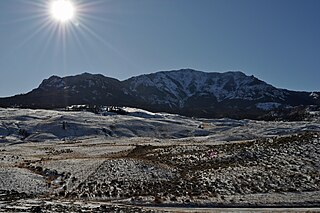
Sepulcher Mountain, elevation 9,642 feet (2,939 m), is a moderate mountain peak in northwest Yellowstone National Park halfway between the summit of Electric Peak and Mammoth Hot Springs. The peak was named Sepulcher by U.S. Army Captain John W. Barlow in 1871 because of its resemblance to a crypt when viewed from Gardiner, Montana.

Judge John W. Meldrum was a carpenter, a Wyoming politician and the first U.S. Commissioner in Yellowstone National Park, a position he held for 41 years (1894–1935).
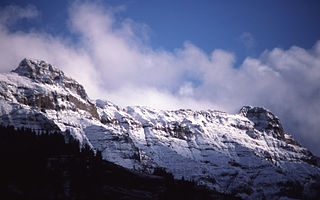
Barronette Peak, elevation 10,354 feet (3,156 m), is a mountain peak in the Absaroka Range, in the northeast section of Yellowstone National Park. The peak is named for Collins Jack Baronette (1829–1901). It was named by the Hayden Geological Survey of 1878, which misspelled it as Barronette; the peak retains the official misspelled name today.

Dunraven Peak el. 9,869 feet (3,008 m) is a mountain peak in the Washburn Range of Yellowstone National Park. In 1874, just two years after the park's creation, The 4th Earl of Dunraven and Mount-Earl, an Anglo-Irish peer, made a visit to Yellowstone in conjunction with a hunting expedition led by Texas Jack Omohundro to the Northern Rockies. Lord Dunraven was so impressed with the park, that he devoted well over 150 pages to Yellowstone in his The Great Divide, published in London in 1874. The Great Divide was one of the earliest works to praise and publicize the park.
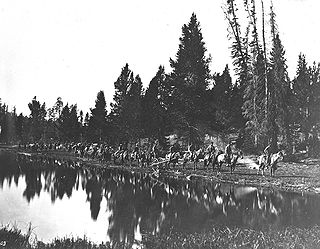
This list summarizes the major expeditions to the Yellowstone region that led to the creation of the park and contributed to the protection of the park and its resources between 1869 and 1890.
Meldrum Mountain el. 9,468 feet (2,886 m) is a mountain peak in the southwestern section of the Gallatin Range in the Montana portion of Yellowstone National Park. The mountain was named in 1962 by the National Park Service for Judge John W. Meldrum the first U.S. Commissioner in Yellowstone National Park, a position he held for 41 years (1894-1935).
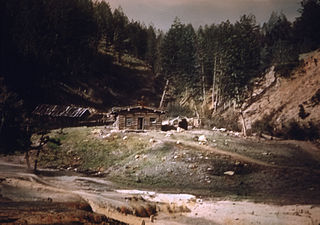
Since before the creation of Yellowstone National Park in 1872, entrepreneurs have established hotels and permanent tourist camps to accommodate visitors to the park. Today, Xanterra Parks and Resorts operates hotel and camping concessions in the park on behalf of the National Park Service. This is a list of hotels and permanent tourist camps that have operated or continue to operate in the park.

The following works deal with the cultural, political, economic, military, biographical and geologic history of pre-territorial Wyoming, Wyoming Territory and the State of Wyoming.




















